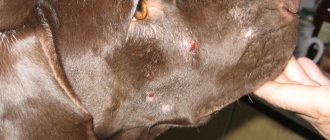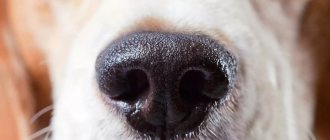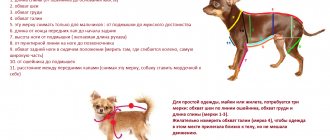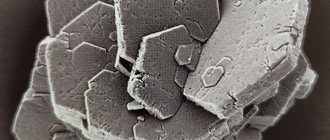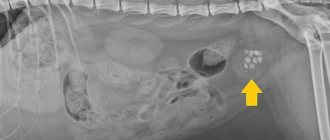Ascites is the most severe pathology of dogs, which occurs as a result of some abnormal process on the part of the internal organs. The condition is dangerous because a large amount of fluid accumulates in the abdominal cavity. In average dogs, the volume can reach up to 10 liters or more. If ascites is left unattended, it will threaten the animal’s life.
Let's look at what most often causes ascites in a dog. How to determine what exactly is fluid in the abdominal cavity, what measures to take and whether it is possible to save the animal or extend its life.
What is ascites in a dog
Dropsy of the abdomen is not a disease, it is a condition that develops and accompanies other diseases. The accumulation of fluid provokes compression of the internal organs, as a result of which the body’s functioning is disrupted. The condition can be triggered by various serious diseases. Sometimes abdominal ascites is the first sign to identify more serious ailments in a dog.
Symptoms and dangers
Ascites in a dog: symptoms
Symptoms of dropsy depend on the severity of the pathology and the volume of fluid accumulated in the peritoneum. The most characteristic sign of ascites in dogs is a symmetrically distended abdomen.
With dropsy, a lot of fluid accumulates in the pet’s peritoneum and when the body position changes, the belly takes on a different shape. If you lay a dog on its back, its belly will spread out to the sides, like a frog's. If the dog is placed on its hind legs, the belly will drop down and take on a pear-shaped shape.
You can suspect ascites in a dog based on such characteristic symptoms as:
- decreased activity;
- loss of appetite (anorexia);
- weight gain;
- vomit;
- dyspnea;
- swelling;
- copious diuresis;
- gait disturbance;
- increased thirst;
- moaning sounds when lying down;
- atrophy of muscle mass.
Difficulty breathing (or shortness of breath) can also occur due to swelling in the abdomen putting pressure on the chest, or due to the associated accumulation of fluid in the space between the chest wall and the lungs (called pleural effusion). Male animals sometimes experience fluid accumulation in the scrotum or penis.
With ascites, the dog's mucous membranes change in color. Due to the lack of oxygen caused by the abundance of fluid, they become bluish, but if the liver is damaged, they can turn yellow.
On a note! With dropsy, dogs often experience impaired swallowing reflexes and difficulty chewing food.
In advanced stages of ascites, up to 20 liters of fluid accumulates in the animal’s peritoneum, putting strong pressure on the internal organs. Due to the enormous load, the dog’s concomitant diseases worsen and it may die.
How to protect your pet?
There are no preventive measures against abdominal hydrops. You should visit a veterinary hospital in a timely manner and get tested regularly. This will allow you to immediately identify diseases in your pet.
A sick dog needs extra attention. If surgical intervention is necessary, it is important to agree with the doctor so as not to risk the life of your pet. After surgery, active therapy is required.
The veterinarian will provide a list of necessary medications, give instructions, and nutritional recommendations. Owners must understand that the health of the animal depends on their care and love. Self-medication with human medications should not be practiced.
Causes of ascites in dogs
The development of abdominal hydrops in healthy dogs is impossible; such cases have not been recorded in veterinary practice. Dogs often die from this condition because their owners mistook the external signs for pregnancy or obesity. To avoid such consequences, you need to understand why a dog may develop ascites:
- Peritonitis is an inflammation of the peritoneal lining, fluid accumulation occurs due to loss of elasticity of the walls of blood vessels;
- Benign and malignant neoplasms, abscesses in the abdominal area. The presence of a tumor provokes disturbances in the outflow of lymph. The condition is very dangerous in the presence of abscesses, which can burst at any moment. The entire contents of the abscess accumulate in the abdominal cavity and intoxication of the animal’s body develops;
- Liver disorders. Any problems with this organ in dogs can cause ascites. The organ loses its ability to filter lymph. Due to slow filtration, stagnation occurs; over time, fluid begins to leak into the abdominal cavity;
- Kidney disorders. Pathologies of this organ can provoke excessive excretion of protein from the body. Lack of protein can cause fluid to accumulate in the abdomen;
- Cardiac ascites. In this case, the accumulation of water is accompanied by disturbances in the functioning of the heart. The body cannot cope with blood circulation, which is why stagnation develops.
- Protein fasting. Lack of a sufficient amount of this substance in a dog's diet can also be a provocateur of ascites.
Read Removing the fifth toe from a puppy and an adult dog: 3 stages
Of course, it is impossible to identify the cause on your own; any self-medication can lead to the death of the animal. The cause is determined through laboratory and instrumental diagnostics in a veterinary clinic. In this case, the specialist collects an anamnesis, which includes a description of the symptoms.
Prevention
The development of abdominal hydrops in a dog cannot be predicted. Often the cause may be a congenital abnormality of the circulatory system. However, you can improve your pet’s quality of life to reduce the risk of developing any pathologies.
- You need to be careful when choosing a puppy. Already at this stage there are many pitfalls. If you take a dog from a kennel, you need to be sure of the pedigree of the dog’s parents and that the breeder takes a responsible approach to his business. This is the only way to reduce the risk of congenital anomalies.
- Timely vaccinations and treatments against external and internal parasites will protect your dog from many diseases.
- The diet should be complete and balanced.
Owner stories
Tatyana : “At first, our dog began to lose weight, although she ate as usual. We went to the clinic, where we heard a disappointing diagnosis - there was a malignant neoplasm in the liver. After some time, I noticed that the dog’s belly had become enlarged. We went to the doctor again. The dog had an ultrasound and the doctor said that all organs were “floating” in ascites fluid. Immediately after the study, the fluid was pumped out, but the doctor warned that this condition would recur. Every 2 months we came to pump out this liquid. They gave me medications to stabilize my condition and diuretics. A year later, our dog was gone.”
Vadim : “My male dog was 12 years old. I began to notice that he breathes through his mouth all the time, even when it is not hot and when he is calm. I called a doctor, he took blood tests, but all the main indicators were normal. Then the dog was prescribed another heart test and it turned out that he had developed heart failure. They prescribed heart medications, I gave them to the dog at home with food. Six months later, the condition worsened again - again he was breathing heavily, did not eat, and his stomach was still swollen. We went to the clinic, it turned out that ascites had been added to the heart problems. The doctor explained how to deal with the problem - periodically pump out the fluid. So I came once a month for this procedure. The dog got worse each time and he had to be euthanized.”
Views: 992
Symptoms of ascites in a dog
Ascites is a very difficult period in the life of any animal. The condition occurs with severe symptoms and external signs. The following symptomatic picture is typical for abdominal dropsy in a dog:
- Severe bloating and protruding sides. In large dogs, this is difficult to notice in the initial stage, but ascites in a dachshund, for example, should be noticeable literally in the first day.
- Dyspnea. If dropsy develops slowly, then at first the dog will suffocate when running, and then it gets worse. Shortness of breath torments the dog even when it is just lying down.
- Due to breathing problems, your pet spends a lot of time sitting; this position allows him to breathe more easily.
- Change in color of mucous membranes. They usually turn blue, but if ascites is caused by liver problems, the color will be yellow.
- Swelling. May be a sign of ascites if the dog has other symptoms.
- Dropsy due to kidney failure may be characterized by high water consumption and frequent trips to the toilet.
- Slow, often painful movement. This condition causes the dog to reduce activity, and over time, general exhaustion is characterized by lethargy, drowsiness, and apathy.
- Decreased appetite.
Despite the lack of appetite, the animal's body weight continues to grow. This is associated with the progression of dropsy. Sometimes, due to ascites, the body is poisoned and the dog begins to vomit. The presence of such symptoms is a signal for an urgent visit to the veterinarian.
Causes of the disease
The causes of dropsy in dogs include congenital and acquired diseases, accompanied by the formation of transudate and exudate (edematous fluid). Both types accumulate in tissues and body cavities, causing disruptions in the functioning of internal organs throughout the body.
Most often in animals with ascites the following is found:
- Abdominal injuries causing internal bleeding, swelling or inflammation.
- Infectious and parasitic diseases. Any pathogenic microorganism releases toxins during its life processes. In response to this, the body launches an inflammatory response.
- Neoplasms of various etiologies. A sudden rupture of a cyst can result in peritonitis, an inflammation of the peritoneum. It is also possible that natural blood circulation may be disrupted due to the growth of cancer cells. They block lymphatic vessels and increase their permeability.
- Heart pathologies. Problems with blood circulation occur with heart failure and other disorders that lower the heart rate.
- Kidney and liver diseases. Due to disruption of the filtration function, all toxins and breakdown products accumulate inside the body, causing inflammation of other organs and systems.
- Hormonal disorders. The problem often occurs in animals that are overweight and have high cholesterol levels. Both factors provoke the development of diabetes mellitus.
Another possible reason is poor nutrition. The risk group includes pets with vitamin deficiency, protein deficiency and sodium excess.
What to feed
If the appetite is preserved, then the dog is given food rich in protein. It could be chicken or turkey breast. They are pre-boiled or simply doused with boiling water. Carbohydrates and fats are reduced to a minimum. For porridges, you can add a little buckwheat or rice. Salt is completely excluded.
Appropriate industrial therapeutic diets are prescribed if the underlying disease is identified.
The dog's fluid intake should be reduced by pouring smaller amounts into the bowl and limiting access to water sources.
Diagnostics
A visit to the veterinarian begins with interviewing the dog's owner to describe the symptoms. Next, an external examination takes place with a detailed medical history. Usually these actions are sufficient to determine the diagnosis, but not complete. Ascites in dogs can be caused by various reasons; additional studies are carried out to identify the causes:
- Ultrasound examination of the abdominal cavity;
- X-ray of the abdomen;
- Puncture with collection of fluid accumulated in the abdomen;
Read How to recognize allergies in a toy terrier: the best treatment methods
Additionally, cardiac echocardiography may be prescribed. Research helps to make an accurate differential diagnosis; resorting to treatment without making a diagnosis is prohibited.
Therapy methods
Treatment for ascites in dogs involves treating the underlying cause, relieving symptoms, and removing excess fluid. The first point is the most important, since without it symptomatic therapy gives only a temporary effect.
Medication
When sepsis and hypoxia are detected, blood transfusions and oxygen therapy are used, but most often treatment is limited to medication. Excess fluid is removed with diuretics, and all other drugs are selected individually:
- cardiotonics that stimulate the heart;
- antibiotics that destroy the causative agent of the detected infection;
- immunomodulators that prevent secondary infection by viruses or bacteria;
- analgesics that suppress attacks of pain;
- antiemetics, eliminating nausea and vomiting;
- sedatives and antipyretics;
- colloidal solutions that normalize protein levels.
Safe dosages and procedures for taking medications are determined by your veterinarian. They may differ from the instructions inside the package, since many medications are intended for human use.
Surgical intervention
Surgical treatment of dropsy in dogs is used when there is extremely high internal pressure and there is no effect from taking medications. In both cases, laparocentesis, or abdominal puncture, is used. In this procedure, effusion is drained through a small puncture in the abdomen. During the manipulations, the animal is under general anesthesia.
Also, indications for surgical intervention are necrosis, abscesses, internal bleeding and malignant neoplasms that do not have metastases. In these cases, treatment comes down to excision of dead tissue, cleansing of the purulent cavity, restoration of damaged tissue, or removal of the tumor.
Auxiliary folk remedies
Traditional medicine is used exclusively to eliminate symptoms. The recipes used are not able to affect the ascites itself, so in no case limit yourself to them.
Attention!
Many animals are prone to grass allergies. To be safe, use infusions and decoctions only under the supervision of a veterinarian.
You might be interested
Diarrhea in a dog - how to treat it and why it occurs
Diarrhea or diarrhea in a dog is a very annoying phenomenon. On top of everything else, it can greatly …read more
What is a dog's normal body temperature and how to measure it
The easiest way to determine the well-being and health status of a dog is to measure its temperature. But you need to take into account that ...read more
The dog sheds a lot - should you worry and what to do?
When purchasing a dog for home, you should be prepared for any “surprises”, including periodic shedding ...read more
Conclusion
The veterinarian, first of all, needs to find out the pathology that led to the appearance of the disease. Only in this case, when carrying out an effective treatment, can we expect that the liquid will not accumulate again. It is also important to take care of your dog's diet. During the treatment period, the dog is placed on a salt-free diet and is limited in fluid intake.
Currently reading:
- Thyroid dysfunction in dogs (hypothyroidism)
- What to do if your dog has an abnormal bite
- How to recognize signs of dog poisoning from rat poisons
- Seven Signs and Remedies for Getting Rid of Fleas in Dogs
Treatment regimen for ascites in dogs
Based on the diagnosis, the veterinarian prescribes treatment. The principle is that it is not the ascites itself that is treated, but the causes of its occurrence. This therapy consists of taking medications and performing surgery. Some veterinarians allow the use of folk remedies, although their effectiveness has not been proven. Before carrying out such measures, the veterinarian may perform a procedure for pumping out fluid from the abdomen, but this will only provide temporary relief.
If ascites is detected, the veterinarian must prescribe a special diet for the dog to avoid complications.
Treatment with drugs
In the vast majority of cases, the veterinarian prescribes diuretics (diuretics), as well as antihypertensive drugs. Typically, specialists prescribe the following drugs:
- Diacarb, Dichlorothiazide, Furasemide, Veroshpiron (diuretics);
- Losartan (antihypertensive drug);
- Sulphocamphocaine, Cordiamin (analeptics);
The choice of a specific drug, dosage and duration of administration is determined by a specialist depending on the condition of the dog. To maintain the normal functioning of the body, hepatoprotectors and cardioprotectors can be prescribed.
In case of dehydration, an infusion of an isotonic solution is given. If severe breathing problems are observed, the dog is given an oxygen mask to stimulate breathing. In case of blood infection due to ascites, a blood transfusion may be performed.
Laparocentesis
The procedure can save the animal’s life in emergency cases. The operation of laparocentesis involves pumping out accumulated fluid in the dog's abdominal cavity. Carrying out the procedure gives time for full treatment of the root causes of dropsy. The scheme for performing laparocentesis is as follows:
- Preparing for the procedure. The dog is given sedatives. In the area of the procedure, the hair is shaved and treated with an antiseptic.
- Insertion of a catheter needle. It is inserted almost along the white line of the abdomen, but slightly from the side. Usually the contents of the dog's belly will begin to come out on their own, but if not, the veterinarian will gently press on the belly.
- Complications may occur during the procedures. The dog may become ill and may develop heart failure. An experienced veterinarian will never perform an operation on his own; there must be at least two specialists or an assistant.
Read Etiology of actinomycosis in dogs: signs, therapy and prevention
After the operation, the dog will begin to feel much better. This condition will not last long and the causes of this condition must be treated.
Folk remedies for home treatment
Treatment at home involves taking medications prescribed by a veterinarian. Folk remedies cannot be used without the permission of a doctor, and he is not responsible for the result of such manipulations. Reviews on forums say the opposite; dog owners talk about the effectiveness of such recipes.
To prepare a remedy for ascites you will need 800 grams of parsley and milk. The greens are placed in a bowl and poured with milk, then put in the oven preheated to 70 degrees and left for 30 minutes. Then this milk is given to the dog 200 ml once a day.
The recipe is provided for informational purposes only. We do not recommend using it without a specialist's prescription.
Popular questions
How long can a dog live with ascites?
It all depends on the actual disease that caused the ascites and on the volume of fluid that has accumulated in the abdominal cavity. If the initial disease is easily stopped and help is provided to the animal in a timely manner, then ascites will not affect life expectancy in any way.
Are there any chances to cure a dog from ascites?
The question is, is there a chance to cure a dog from the disease that resulted in ascites? If the cause is a tumor, then the chances are not so great; in other cases, the prognosis is more favorable.
Can you get ascites from a dog?
No, this condition is not contagious to humans or other animals.
Why does ascites build up again after a puncture?
This is not surprising, simply pumping out the fluid does not solve the main problem; you need to fight the disease that led to dropsy.
What to feed when sick?
Once diagnosed, your pet may need a special diet depending on which organ is damaged. If the veterinarian has not received any recommendations on feeding, then the main thing is that the diet is complete and balanced, with sufficient protein content.
Abdominal hydrops and its etiopathogenesis
In veterinary practice, ascites is not considered an independent disease. Dropsy is considered as a consequence of serious pathological changes in the body. With ascites, the pet’s condition worsens as a result of the accumulation of excess fluid in the peritoneal cavity - transudate, while there are no inflammatory processes in the tissues. The volume of excess liquid in some cases reaches 20 liters. If the dog is not given effective therapy as soon as possible, the prognosis for the pet is poor.
Treating ascites at home is strictly prohibited; using traditional methods will only worsen the pet’s condition. Abdominal dropsy requires only qualified veterinary care in special conditions.
How to cure dropsy in dogs? First aid
Any dog owner, seeing the symptoms of any disease, not just dropsy, will want to help their pet as quickly as possible. If you have dropsy in dogs, you need to understand that help should be provided by specialists. Because ignorance of the anatomy of an animal and its physiological characteristics can cause harm to your beloved pet.
If you witness signs of dropsy, first of all, keep your dog calm
, give her more fluids.
Next , immediately call an emergency veterinary team
by contacting our. Our doctors act quickly and efficiently.
If you decide to transport the patient yourself
, be extremely careful not to harm the animal’s body. Upon the dog’s arrival at the center, all necessary examinations will be carried out to correctly diagnose the disease, after which therapeutic measures will be prescribed.
In most cases, treatment requires surgery. Don’t worry, we accompany our patients even after full recovery to ensure that the treatment is completed
Clinical signs
In a dog with ascites, you can observe not only a swollen belly. A sick animal cannot breathe freely , and it is difficult for her to inhale due to the intense tension of the inspiratory muscles, but exhalation is not difficult.
With this disease, the animal may experience problems in the gastrointestinal tract in the form of:
- Constant constipation.
- Diarrhea.
If an animal develops dropsy of the brain, it does not remain in a conscious state for a long time; the clinical picture in such a case is expressed in the form of coma or lethargy. When his pet coughs, the owner can hear the gurgling of the liquid in it.
Due to the occurrence of ascites, the pet develops anorexia . During illness, the animal eats practically nothing; against the background of excessive thinness, the huge belly is very noticeable.
Prepare before going to the vet
In the office, you may have to provide the veterinarian with all possible assistance (hold the animal while they take blood for analysis, give an injection, extinguish aggression, calm your voice, scratch its ears, stroke it). If you know that you are terrified of blood, IVs, or definitely cannot withstand the type of medical interventions, then perhaps you should ask a friend or relative for help.
Find a veterinary certificate, veterinary passport.
https://dog-care.ru/zdorove/bolezni/astsit-lechenie-domashnih-usloviyah.html
Take:
- Leash;
- Collar;
- Muzzle;
- Carrying;
- A pack of napkins;
- litter;
- Bowl, water (at the veterinarian's discretion)
Prepare answers to possible questions from the veterinarian:
- Are all vaccinations up to date on the animal?
- Pet’s behavior in recent days, appetite;
- His diet;
- What drugs and medicines did you give to the animal;
- Latest test data (if available).
It’s better to make an appointment in advance - you’ll save time and be able to calculate when you’ll have to take time off. This does not apply to life-threatening situations where you will have to take an animal to a veterinary clinic without an appointment.
Be affectionate with your pet, play, talk to him. You can take his favorite toy with you so that while you wait for your turn at the reception, you can distract your friend from the new environment.
Furry, feathered or scaly ones also need to be prepared. No matter how much you want to treat your little one with something tasty, remember: you need an empty stomach. Feeding is prohibited!
You can wash your animal without using detergents. But it is important not to touch your pet if there is nasal discharge, watery eyes, salivation (salivation), dandruff, scratching, rashes, skin scabs, loss of hair/feathers/scales, wounds and other external manifestations of a potential disease.
If the veterinarian has instructed, collect the animal’s urine in a sterile container, and pick up the feces with a stick (no blades of grass, specks, or debris). Transfer the feces into a sterile container. Send to the biochemical laboratory within 6 hours. The feces are examined for eggs of roundworms, pinworms, tapeworms, liver flukes, echinoccus, alvecoccus, pork tapeworm, bovine tapeworm, and gastrointestinal bleeding is detected.
At the veterinary hospital, the animal’s blood will be analyzed for antibodies to allergens, viruses, bacteria, and parasites.
Tactics
Before starting treatment, the doctor prescribes the following tests - ultrasound, x-ray, sampling of abdominal fluid for tests.
Based on the data obtained, a diagnosis is made and appropriate therapy is prescribed, which is aimed at eliminating the causes of ascites.
The dosage and methods of use of drugs that relieve the main symptoms of the disease are determined by the veterinarian.
Drugs
The most commonly prescribed medications are:
- Losartan;
- Veroshpiron;
- Furosemide;
- Eufillin.
In advanced cases of ascites, laparocentesis (pumping out fluid from the abdominal cavity) is prescribed. This procedure can significantly alleviate the dog’s condition and is carried out in parallel with taking medications. Additionally, the veterinarian may recommend taking antibiotics and protein drugs.
Methods
Depending on the disease causing ascites, the following treatment methods are also used:
- taking diuretics helps remove harmful substances from the animal’s body;
- taking cardioprotectors and hepaprotectors stabilizes the functioning of the heart muscle and liver;
- diet with limited salt and liquid.
Dog care
After and during treatment, your pet needs special care.
It is necessary to adjust the diet; depending on the underlying disease, the dog may need a special diet.
If it is already known that the dog is prone to ascites, you need to control the amount of fluid consumed and limit the intake of salt into the body.
Carefully and clearly follow all the recommendations of the treating veterinarian if you want your pet to be healthy.
Indications for use
Indication for this procedure is the presence of free fluid in the abdominal cavity. May be accompanied by severe abdominal pain, fever, and clinical signs of shock.
Laparocentesis is a very sensitive method in the diagnosis of peritonitis, tumor formation in the abdominal cavity, pancreatitis, congestive heart failure, and intra-abdominal bleeding.
Abdominal puncture is performed under ultrasound guidance or blindly. So, if there is more than ml/kg of free fluid, the doctor performs laparocentesis without ultrasound control. With a smaller volume, a false negative result is possible, since fluid accumulates around the abdominal organs or in the omentum. It is also possible for fluid to accumulate inside peculiar pockets.
A false positive result can be obtained by puncturing the liver or spleen.
During the procedure, the doctor monitors the formation of blood clots in the lumen of the needle, since rapid blood clotting indicates damage to the abdominal organs during puncture.
Carrying out diagnostics
If a home test for ascites is positive, do not rush to self-medicate. Treatment methods directly depend on the cause of the disease, so a full examination cannot be avoided. The veterinary clinic will need:
- take urine and blood tests;
- undergo an ultrasound and x-ray;
- make a puncture.
Based on the results, the doctor determines the presence of diseases of the urinary system, injuries and tumors, the level of intoxication, the degree of organ damage, the exact amount and composition of the effusion. Next, the four-legged patient is given an individual treatment plan that takes into account the diagnosis.
Technique
The animal is laid on its side or remains standing. The area where the needle is inserted is shaved and treated with a disinfectant solution. The puncture is carried out with a catheter to the left or right of the midline of the abdomen, slightly above or below the navel. For small volumes and the need to pump out liquid under pressure, a syringe is used. If a large amount of liquid accumulates, it drains away by gravity. By removing a large volume of free (ascites) fluid, a dramatic improvement in the animal’s well-being is possible. For example, in animals with right-sided congestive heart failure, a decrease in compression on the diaphragm is accompanied by a sharp improvement in respiratory function and stabilization of cardiac activity.
Treatment
Dropsy is a consequence of a disease; in order to cure it, it is necessary to get rid of the cause of the disease. Treatment of primary pathology is carried out after its diagnosis. But since diagnosis takes some time, symptomatic therapy is prescribed even before the examination is completed.
Medication
When a significant amount of fluid accumulates, the surgeon pierces the peritoneal wall and removes it.
If the disease does not develop pathologically, then complex therapy with drugs is prescribed:
- Diuretics: Nephropil, Canephron.
- Antibiotics are used to relieve inflammation: Trimethine, Cephalosporin.
- Vitamin complexes are prescribed.
- Hypoprotectors are used: Heptarl, Ursofalk.
- To strengthen the heart, use: Hydrochlorothiazide, Chlortizide.
- During the necrosis of cardiac tissue, the animal is placed in an oxygen chamber.
Folk
If the disease is not caused by severe changes in the internal organs and if the doctor allows the treatment of dropsy with medicinal plants, then the following recipes are used:
- Mix coltsfoot and bean pods with angelica and dried apricots. Brew everything in 1 liter of boiling water, let it brew and take the composition within 24 hours.
- Mix equal amounts of currant leaves, sage and chamomile. Pour the ingredients into 1 liter of boiling water and leave to steep for 25 minutes. Decant and take within an hour.
- Add 1 tbsp to 250 g of milk. fresh parsley, and place in the oven, preheated to 85 degrees. The composition must be simmered over low heat until half the volume has evaporated. The product should be given to the dog once a day.
Use of diuretics
Sometimes diuretics are prescribed to remove fluid. But potassium is removed in the urine, which is released in this way. To maintain it, you need to use special diuretics. But over time, they cause an imbalance in water and electrolyte metabolism. Therefore, do not abuse such drugs.
Good results can be achieved by using protectors for cardio and liver. They help these organs function normally.
The animal's diet should not contain salt, and fluid intake should be minimal.


